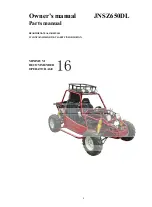
Maintenance & Adjustments
6
14
Engine
Air Filter
The engine air filter should be changed every 50 hours. Change
more frequently if operated in extremely dusty conditions.
Pull up on latch and turn counter-clockwise to release air
1.
cleaner cover. See Fig. 6-1.
Remove cover. Remove and inspect air cleaner element. If
2.
excessively dirty or damaged, replace element.
Reattach cover and secure with latch.
3.
IMPORTANT:
When reattaching cover, make certain that
dust valve is pointing downward. See Fig. 6-1 inset.
Read the Yanmar engine operator’s manual for any other service
or maintenance information pertaining to the engine.
Engine Coolant
Checking Engine Coolant Level
Before each use, the engine coolant level in the overflow
reservoir should be checked to ensure it is within the operating
range. Engine coolant absorbs heat from the engine and
transfers the heat to the air flowing through the radiator. If the
coolant level becomes low, the engine may overheat and could
cause severe damage to the engine.
Use a permanent type antifreeze containing corrosion and rust
inhibitors. Dilute the antifreeze with water at a 1 : 1 ratio to mix
the coolant solution (50% antifreeze : 50% water).
NOTE:
Distilled water is recommended for the coolant solution
IF your tap water has a high mineral content. Minerals cause
scaling in the engine and the radiator coolant passages. System
efficiency will be greatly reduced over time and severe engine
damage may result. Refer to the antifreeze manufacturer’s
instructions for additional information on dilution procedures.
Check the coolant level when the engine is cold and the
1.
utility vehicle is on a level surface.
Raise the hood and check the coolant level in the overflow
2.
reservoir on the right side of the radiator.
If the coolant level is below the “LOW” mark, remove the
3.
cap from the reservoir and add coolant solution to the
“FULL” mark. Refer to Fig. 6-2.
NOTE:
The cooling system is a closed type. Normally, to prevent
air from entering the system, the radiator cap should not be
removed.
If the overflow reservoir is empty, the radiator cap should be
removed and the coolant level in the radiator checked before
adding coolant to the reservoir. If necessary, first refill the system
through the radiator filler neck as follows:
WARNING:
It is dangerous to remove the radiator
cap when the system is hot. Allow the system to cool
before removing the radiator cap.
Figure 6-2
Figure 6-1
Cover
Dust
Valve
Element
Latch















































